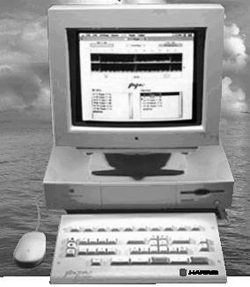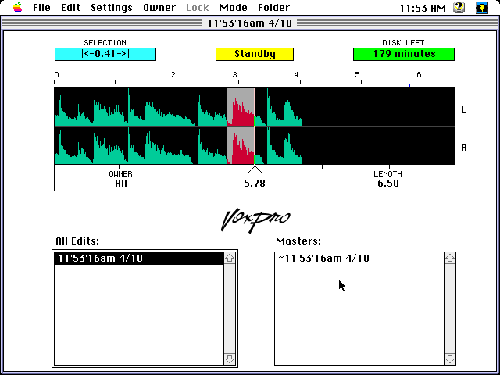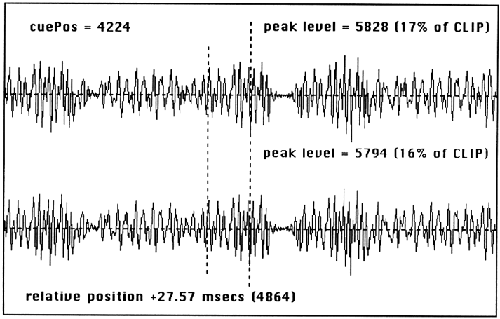 By Jerry Vigil
By Jerry Vigil
Though the comprehensive manual is 200 plus pages long, it begins with the sentence, “Since some VoxPro users will not read any part of this manual, Audion Labs has designed an interface that makes it possible to accomplish most editing tasks without memorizing command keys or looking anything up in the manual.” They weren’t exaggerating. The VoxPro takes digital editing to its simplest level, eliminating multiple screens, seldom-used functions, and special effects. The result is a very straightforward and very intuitive 2-track digital editor that your favorite salesperson might even figure out in a few minutes. The unit was designed primarily for recording and editing phone calls in the on-air studio as well as news preparation, but VoxPro serves as a great tool in production as well.
 VoxPro is software developed by Audion, a company headed by legendary boss jock Charlie Brown who recently retired from KJR-FM in Seattle after 30+ years in the biz. VoxPro has been around for a few years and has found a home in hundreds of stations. It is distributed exclusively by Harris Broadcast as a completely configured system. The unit shipped for this Test Drive included a PowerMac 200mHz computer with 16 megs of RAM, a 1.9GB drive, a 14-inch monitor, keyboard/mouse, and the well designed remote control panel with dedicated controls for the VoxPro software. VoxPro’s I/O is stereo in and stereo out using the Mac’s mini-plug I/O ports. A Henry Engineering MatchBox was supplied for interfacing with pro audio environments. After the basic tasks of installing a computer and connecting the I/O, the Mac was turned on and VoxPro was up and ready to go.
VoxPro is software developed by Audion, a company headed by legendary boss jock Charlie Brown who recently retired from KJR-FM in Seattle after 30+ years in the biz. VoxPro has been around for a few years and has found a home in hundreds of stations. It is distributed exclusively by Harris Broadcast as a completely configured system. The unit shipped for this Test Drive included a PowerMac 200mHz computer with 16 megs of RAM, a 1.9GB drive, a 14-inch monitor, keyboard/mouse, and the well designed remote control panel with dedicated controls for the VoxPro software. VoxPro’s I/O is stereo in and stereo out using the Mac’s mini-plug I/O ports. A Henry Engineering MatchBox was supplied for interfacing with pro audio environments. After the basic tasks of installing a computer and connecting the I/O, the Mac was turned on and VoxPro was up and ready to go.

The Main Screen
VoxPro’s main screen, and only screen for the most part, has so much empty white space, it looks like something is missing from the display. But this is just a representation of how little there is to learn about using the program. The Sound Window takes up most of the top half of the screen and displays the active file’s amplitude waveform. The window always displays six seconds of audio, regardless of the length of the soundfile. If the soundfile is less than six seconds long, it simply occupies a small section of the display. If you have a longer file, let’s say sixty seconds, the timeline at the top of the window displays the total time of the soundfile. A small indicator on the timeline indicates the current cursor position and enables fast navigation within the file. The cursor position remains fixed at the center of the window. Below it, a time display shows the current time from the beginning of the file. A time indicator to the right shows the total length of the active file. Each channel of the waveform is labeled to the right with L and R. Clicking between the L and R sets playback to mono.
Click-dragging the mouse anywhere on the waveform in the Sound Window activates the VoxPro’s scrub function, which is very responsive and vital to marking tight edit points. For more precise marking, press the Zoom In key on the remote control panel. This zooms in to show about a half-second of audio. Though you can’t scrub on the zoom screen, it is easy enough to locate exact edit points visually.
Two windows at the bottom list files available for editing. The left window lists Edits and the right window lists Masters. When a recording is made, the original file is called the Master and it shows up in the Masters window. At the same time, a “working copy” of the original file is placed in the Edits window. Actually, the file on the Edits window represents the editlist file or the set of pointers that represent the edits to the master file. In other words, VoxPro doesn’t actually make a copy of the file just recorded, which would use up lots of disk space, but it gives the appearance of automatically making a backup copy of every file recorded, which is then used for editing. As a result, all editing on the VoxPro is non-destructive. At any time, after editing a file, you can always reclaim the original file.
When a Master or Edit is selected, the waveform appears on the screen quickly, within about a second. There is virtually no load time, and this makes moving from one sound file to another a very quick process. Simply highlight the desired file, and it’s ready for editing. Compiling a project from segments of many other recordings is extremely easy and fast on the VoxPro.
Three large indicators at the top show the length of the selected area, the current operating mode of the program (Standby, Record, Playback), and the amount of recording time available on the disk drive. The title bar above the three indicators shows the current filename. At the very top of the screen are the VoxPro’s pull-down menus. More on those in a moment.
The Remote Control
The VoxPro’s dedicated Remote Control panel has 41 keys that provide access to all of the most used functions of VoxPro. For most operations, the only time you’ll need the keyboard is to name files. All the functions on the Remote Control are also accessible from the keyboard and/or mouse, making it possible to run VoxPro without the Remote Control. But if the object is to present your staff with a user-friendly machine, the Remote Control is a primary step in that direction.
Across the top of the Remote Control are ten keys labeled Cart 1 through Cart 0. They mirror the number keys at the top of the keyboard. These are assignable “hot keys” and simulate having ten cart machines loaded and ready to go. Each producer/jock can have their own set of audio files assigned to the Cart keys. The Cart keys are handy both in the on-air studio and in production for assigning often used elements to such as IDs, music beds, sound effects, etc.. In production, they also serve as convenient temporary “storage areas” for audio to be used later.
At the bottom of the Remote Control panel are five large transport keys. The bright red Record key is a one-key record start function. There’s no dialog box to deal with when recording, no files to name, no parameters to set. Naming is done after the recording. Press the Record key, and you’re recording. There’s also an Insert Record key that provides a very cool function. Select a point in the middle of a soundfile, press Insert Record, and your new recording is inserted in the middle of the file, without overwriting any existing audio. The green Play key is hard to miss and initiates playback of the active file at the cursor or cue position. The Stop key exits the Record and Playback modes. Either mode can also be exited by pressing the Record or Play key again. The Cancel key acts much like the Escape key on a keyboard to cancel a current operation. The OK key simulates the Enter key on the keyboard.
Other transport controls include the Goto Beginning key, which instantly puts the playback cursor at the beginning of the file, likewise with the Goto End key. A set of fast forward and rewind keys act very much like a tape transport and provide that familiar fast forward/rewind tape sound. A second set of reverse/forward keys engages normal speed playback in either direction. And a third set provides 1/2-speed playback in either direction. These six keys offer tape transport in the digital domain that is as close to the real thing as you can get. I was impressed.
Up and Down arrow keys scroll through the filenames in the Edits and Masters windows. The Edit/Master key toggles between the two windows. The Play Beginning and Play Selected keys quickly audition the beginning of a file and the selected area of a file. Ctrl, Opt, and Shift keys, when used together with other keys, provide shortcuts to many functions of VoxPro without having to access the pull-down menus or the keyboard.

Editing
The other keys on the Remote Control are dedicated to VoxPro’s editing functions. You get basic cut and paste editing with emphasis on simplicity. The left and right Select keys mark the area for editing. The selected area is highlighted on the display. Press the Cut key to perform a simple cut and splice edit. The “cut” audio is placed in the clipboard. The Copy key copies the selected audio to the clipboard. The Paste key inserts the clipboard audio at the current cue position, moving existing audio down the track. If you make a mistake, press Undo. There’s one level of undo with VoxPro, but with the Master file always intact, there’s no fear of permanently losing audio in the editing process. The large Delete key removes selected audio but does not place it in the clipboard. It is also used for deleting files. The Clear Selection key cancels commands that select areas of audio. The Zoom In key mentioned earlier brings up VoxPro’s zoom screen for more precise, visual editing.
Since edits are not being performed on the actual audio file, edits are instant. In fact, VoxPro gets a gold star for its speed. It takes very little time to get the hang of editing on VoxPro, and once you do, VoxPro is as fast as digital editing gets. In fact, it’s the equivalent of editing in RAM since all edits are merely changes to the editlist or Edit file.
More On The Menus
Perhaps the coolest part of VoxPro’s design is how it is presented to the user in three levels. At the first level, you’re presented with the control panel and the simple functions already discussed. As mentioned earlier, even someone as inexperienced at digital editing as a salesperson can get the hang of recording and editing on VoxPro. If they understand the simple cut and paste editing of a word processor, they can get the hang of VoxPro. This is what makes the program so attractive to on-air use, where it seems DJ skills these days are limited when it comes to production. At the second level, VoxPro provides pull-down menus featuring additional editing functions, though still nothing a talented jock can’t understand. At the third level, VoxPro can be operated at lightning speed using keyboard shortcuts as well as shortcuts on the Remote Control, and other features such as autolocate markers become available. Though the system doesn’t come close to offering the array of 2-track editing and processing functions as, let’s say, Sound Forge, there is still enough processing power in VoxPro to make the system a viable tool for anyone from the amateur audio hobbyist to the professional producer.
Under the Edit pull-down menu, there are only a few other edit commands not offered on the Remote Control. A handy one is the Bleep command. Say you’re editing a contest winner who shouts a word your Mom might cringe at. Select the area and click the Bleep command. A tone replaces the offensive word instantly. Click the Mute command to simply replace the selected area with silence. The Insert Silence command is the equivalent of leader tape. The Time Slip function is a rare one. It takes audio from the left channel and moves it to the end of the right channel’s audio, or vice versa. This function is designed for setups where the jock is recorded on one channel and the caller on the other. If the caller is talking at the same time as the jock at some point in the conversation, the Time Slip command separates the two. A Cross Fade function performs a pre-set cross fade between an edit point that needs smoothing due to clicks.
One nice function in the Edit pull-down menu is the Select Region function. If you create a project using regions from various soundfiles—such as you might when producing a multiple winner montage promo, pulling sound bites from several separate files—clicking the Select Region command while the cursor is on any part of one of those regions will select that entire region. Furthermore, clicking on the Goto Master function will bring up the Master file that contains that region with the region highlighted on the Master file.
There are only a few other pull-down menus, and each of them offers only a few options, keeping VoxPro streamlined and friendly. A few choices under the File menu provide file creation, deletion, and renaming functions. The Settings menu is system oriented and may never be accessed by the average user. Set levels, headroom, turn on the AGC (nice feature), turn on the on-board oscillator (another helpful tool), set the record start mode to record automatically when audio is present, and more.
The Owner menu opens work areas for each jock/producer and provides password protection for each owner’s files. The Lock menu locks or unlocks files, preventing or allowing them to be erased. The Mode menu sets the record mode to mono or stereo, doubling record times for mono voice tracks. And finally, the Folder menu permits creating an entirely new work area (on the drive) for a whole new set of Owners. I must say, the pull-down menus on VoxPro offer the fewest and simplest choices I’ve seen on digital editing software. If I were asked how to help move a die-hard analog tape lover into the digital domain with no pain, I’d suggest VoxPro without a blink.
Wrapping It Up
As mentioned, VoxPro is sold exclusively by Harris Broadcast as a completely configured system. The PC-100C model includes the computer, monitor, keyboard, software, 100 minutes of stereo recording time, and the Remote Control panel for $3,695. For $4,195 you get 180 stereo minutes of recording time. Either system is available with the higher quality Audio Media III sound card for $4,616 and $4,858 respectively. The sampling frequency is fixed at 44.1kHz, though it seems 32kHz would be ideal, especially for a system designed primarily for voice and phone call editing. Recording is 16-bit linear. The version number of the software used for this review is 1.8.3.
Above all, the most impressive feature of VoxPro is the short learning curve, so short in fact, it’s fair to say there is no learning curve at all if you have any experience with a computer and editing analog tape. While many 2-track digital audio software programs on the market offer a vast assortment of features, functions, and options, VoxPro avoids trying to compete with any of them. While the others constantly try to outdo each other by increasing the amount of features, VoxPro stands alone as a simple 2-track editor, doing its best to retain the familiarity and friendliness of that trusty reel-to-reel most of us grew up on.
There’s no doubt that the VoxPro’s ease of use makes it a good choice for the on-air studio or news editing room. But VoxPro is a very handy production tool, too. My favorite feature in production is the quick, one-key record function. VoxPro is always ready to record. It’s the equivalent of having tape on a reel-to-reel, loaded and ready to go, only better. Every time you hit record, you create a new file, so it’s easy to keep track of what you’re recording. Long filenames are permitted, so descriptive filenames make it easy to see what’s on the drive. Separate folders can be created for different types of soundfiles—sound effects, music beds, voice tracks, IDs, etc.. VoxPro is ideal for getting voice tracks for later placement into a digital multi-track. Do your editing in VoxPro, then dump the finished track into your main system, preserving that precious disk space. Use VoxPro as a sound bite archiving system, filing all your movie and TV drops for easy recording, editing, cataloging, and recall. Of course, if you prefer Macs over PCs, you already have reason to like VoxPro. Furthermore, you are able to run other Macintosh software on the computer, so it’s not like VoxPro is all you get for the money.
♦

